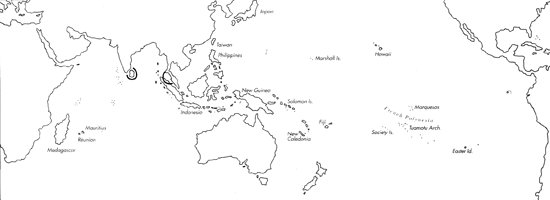
Skip Navigation Links
View access keys for this site.

Range: Raya Id., W. Thailand, and Sri Lanka.
Description: Moderately small to medium-sized, moderately solid. Last whorl conical or broadly conical, sometimes ventricosely conical; outline convex adapically, less so or straight towards base. Shoulder angulate. Spire of moderate height, outline deeply concave. Larval Shell multispiral, maximum diameter 0.8-0.9 mm. First 4-6 postnuclear whorls tuberculate. Teleoconch sutural ramps flat, with 1 increasing to 3-4 spiral grooves. Last whorl smooth or with variably granulose spiral ribs extending varying distance from base, occasionally to shoulder.
| Shell Morphometry | ||
|---|---|---|
| L | 25-48 mm | |
| RW | 0.10-0.37 g/mm | |
| RD | 0.65-0.72 | |
| PMD | 0.83-0.95 | |
| RSH | 0.12-0.19 | |
Colour orange, often lighter at base of last whorl. In smaller specimens, last whorl often with a pale or distinct yellow spiral band at centre. Larval shell white. First 4-5 postnuclear sutural ramps white; later ramps may have brown axial blotches in subadults. Aperture white.
Periostracum brown, becoming thicker and opaque during growth, with widely set and strongly tufted spiral ridges on last whorl crossing closely set axial ridges; sutural ramps with heavy, regularly wide-set radial tufts.
Habitat and Habits: In 25-40 m; on sand bottom with rocks.
Discussion: C. rawaiensis is most similar to C. circumactus, which attains larger size and has a narrower last whorl (RD 0.58 -0.67), lower spire (RSH 0.05-0.14), and a violet base.

C. rawaiensis range map
This section contains verbatim reproductions of the accounts of 316 species of Conus from the Indo-Pacific region, from Manual of the Living Conidae, by Röckel, Korn and Kohn (1995). They are reproduced with the kind permission of the present publisher, Conchbooks.
All plates and figures referred to in the text are also in Röckel, Korn & Kohn, 1995. Manual of the Living Conidae Vol. 1: Indo-Pacific Region.
The range maps have been modified so that each species account has it own map, rather than one map that showed the ranges of several species in the original work. This was necessary because each species account is on a separate page on the website and not confined to the order of accounts in the book.
Return to framed version (returns to search page)